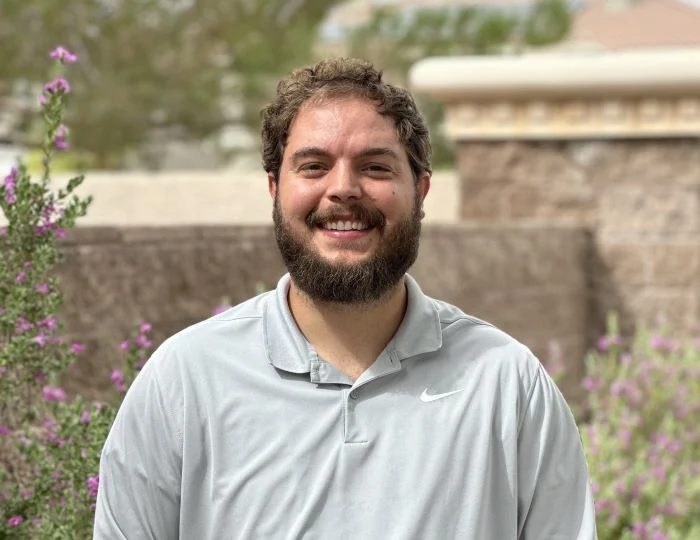In Las Vegas, where turf is scarce, and careful water management is critical, Par 3 Landscape Management has become an oasis in the desert. Specializing primarily in HOA management alongside commercial maintenance, construction, lawn care, tree, and irrigation services. The company has a reputation for innovation, and it counts some of the swankiest properties in town, including Las Vegas Boulevard, “The Strip," as its clients.
Brad Hill, Director of Operations at Par 3 Landscape Management, blends his passion for new and creative ways of thinking and his love of the outdoors in his daily work.
“I've always loved being outside, and I've always been a blue-collar worker. That's just what I grew up doing,” he says.
Hill dreamed of making a career and a name for himself in the green industry.
"Honestly, you can make money (in this industry), but you have to find the right company that has the same goals and visions as you and is willing to invest as much as you are,” he said.
Hill’s love of landscaping started at age 8 when he started a lawn mowing business with his brother, who was 10 years old. At ages 12 and 14, the duo transitioned into commercial work, securing some of the major hospital campuses in Denver—including one contract they won over ValleyCrest.
His victory over the landscaping behemoth ValleyCrest aside, he had bigger goals in the industry.
Hill enrolled at Brigham Young University, Idaho, and competed with BYU’s team at the National Collegiate Landscape Competition for three years, winning many of the competitions' irrigation events. BYU’s reputation as a leader using innovative industry tools like Aspire and Weathermatic made graduates of the program extremely marketable to future employers.
Armed with his horticulture degree and estimating and budgeting skills honed by Aspire, he entered the job market. He found a new home in Las Vegas with Par 3 Landscape Management, creating and launching their irrigation division.
When he joined the Par 3 team, the company used Excel and other Microsoft programs to manage day-to-day operations.
“I said, ‘Hey, I know I'm new, but it would be beneficial if we use landscape management software, and I have one I used in college called Aspire. It's pretty great, and you should look at it,’” he recalls.
Par 3 had tried Capture briefly and then returned to paper and Excel until Hill implemented Google Sheets as an interim solution.
“I was doing inventory, and time and material tracking all on Google sheets that our irrigation techs and maintenance people filled out in the field,” Hill says. The constant data entry and the disconnection helped the leadership team buy into Aspire.
“We've been able to improve our bidding and get everything centralized, which has probably been the biggest help,” he says. “Now, everyone's on the same page, working within the same platform, using the same templates. It’s helped us get our efficiency and productivity where we want it to be.”
Growing plants and career paths
While Hill was at BYU, irrigation became his specialty in the landscaping field. His irrigation and water management philosophy goes beyond the “save water, save money” motto.
“It's not about just cutting water; it's about providing long-term plant health with irrigation water management,” he says, noting sound water management practices mean giving plants the precise amount of water needed using the suitable irrigation technology.
Over time, the irrigation division hit $2 million, and he and water manager Tom Raden became the market's irrigation and water management experts. The irrigation division has grown from a few irrigators to a team of irrigation technicians, Irrigation Field Managers, and multiple irrigation managers.
“I think that's the coolest thing—creating something that's now become a career path for other people within the company,” he says.
Hill and Raden push the team to experiment with new products and discover new ways to lengthen the life span of its irrigation installations, which helps generate leads and builds their reputation for installing top-notch irrigation systems.
Looking to translate the growth of the irrigation division into developing standard operating procedures for the entire organization, the company made Hill the director of operations.
Eliminating reactivity and promoting proactivity
Par 3 has 525 employees, and as with any field-service-based company, tracking actual versus estimated hours is a significant concern. Hill meets with the executive team daily to identify inefficiencies and inconsistencies in Par 3 workflows and uses Aspire to:
Accurately estimate hours and materials
Identify budget overages and causes
Effectively manage time and resources
Forecast, plan for, and schedule upcoming work
Manage vehicle and equipment fleets, tracking vehicle registration, renewals, and routine maintenance.
The above is just a short list of what he’s managing in Aspire, and he’s always looking to fine-tune processes. “I've tried to get us to think ahead when it comes to vision, planning, and operations versus being reactionary,” Hill says.
Enabling better visibility to hit financial goals
Par 3 generated $40 million in revenue in 2022 and is targeting $45 million this year. It takes sophisticated software to manage the volume of information necessary to operate a company this size and successfully hit these goals.
Without Aspire, managing operations would be “pretty horrible, to be honest,” Hill admits. “It provides a holistic view of the past, present, and future of how the company is running, what the operation looks like, and what needs to be done.”
“Without it, I would lose that vision and be stressed, thinking, ‘OK, I don't know what we've done. I hope I know what we're doing, and let's try and guess what we can do in the future,’” he adds.
Before Aspire, Par-3 used a lot of time and resources to track P&L’s which required lengthy monthly and quarterly meetings with analysts and the CFO to decipher the data.
“Now we have real-time tracking, and on any day, any manager can log into the system and see exactly where they're at on their gross margins on each property across their entire portfolio,” Hill says.
Branch and division managers have access to complete historical information, enabling them to make timely decisions based on reliable data.
“It's been helpful and insightful to give our people the ability to understand where they're at—not once a month or once a quarter, but every single day,” Hill adds.
“Scheduling went from 3-4 hours a day to 30 minutes”
Specialties like irrigation, spray, and tree care are shorter and less routine than maintenance or construction jobs. Hill’s primary concern was scheduling technicians for maximum productivity and efficiency. He spent hours each day envisioning where his 10 technicians were going all over Las Vegas and planning for contingencies if a tech needed supplies or assistance on the fly.
“It was horrible because every day is different, and you have to make sure you have enough work to keep your techs busy so they can support their families,” he says. “You have to know where they're going; ensure they have everything they need, and it has to be efficient.”
Aspire’s scheduling feature allowed him to view all work tickets on a map and optimize all routes with a single click.
“Aspire cut the scheduling process from three or four hours to 30 minutes,” he says. “Being able to schedule, lay out, and route jobs has been night and day since we switched to Aspire.”
Enabling strategic and sustainable growth with Aspire
When Par 3 began to look for a software solution, the process centered around finding software to house their data. “Our goal was to find a company that cares about the quality and expertise of landscaping and the why behind what we do, as much as the business of what we do,” Hill says.
He welcomed the opportunity to start with a blank slate in Aspire and had several meetings with Aspire implementation experts to explain current and ideal irrigation workflows. The Aspire team guided them to the best practices to improve reporting and data gathering.
Hill wants to dispel the perception of Aspire among people who don’t use it.
“It probably seems pretty complicated (from the outside). There's a lot of work that goes into adopting any new technology,” he says.
Hill explains that technology should be used to solve a problem, and if they’re not used with a purpose in mind, it often adds more complexity and work. But Par 3 is laser-focused on how Aspire can solve their challenges.
“I haven't seen an issue in irrigation, spraying, maintenance, or construction that can’t be solved with Aspire,” he says. “Aspire is a great solution for almost anything you want.”
Ready to learn how you can creatively solve the challenges in your landscape business? Book a free, personalized demo today.










